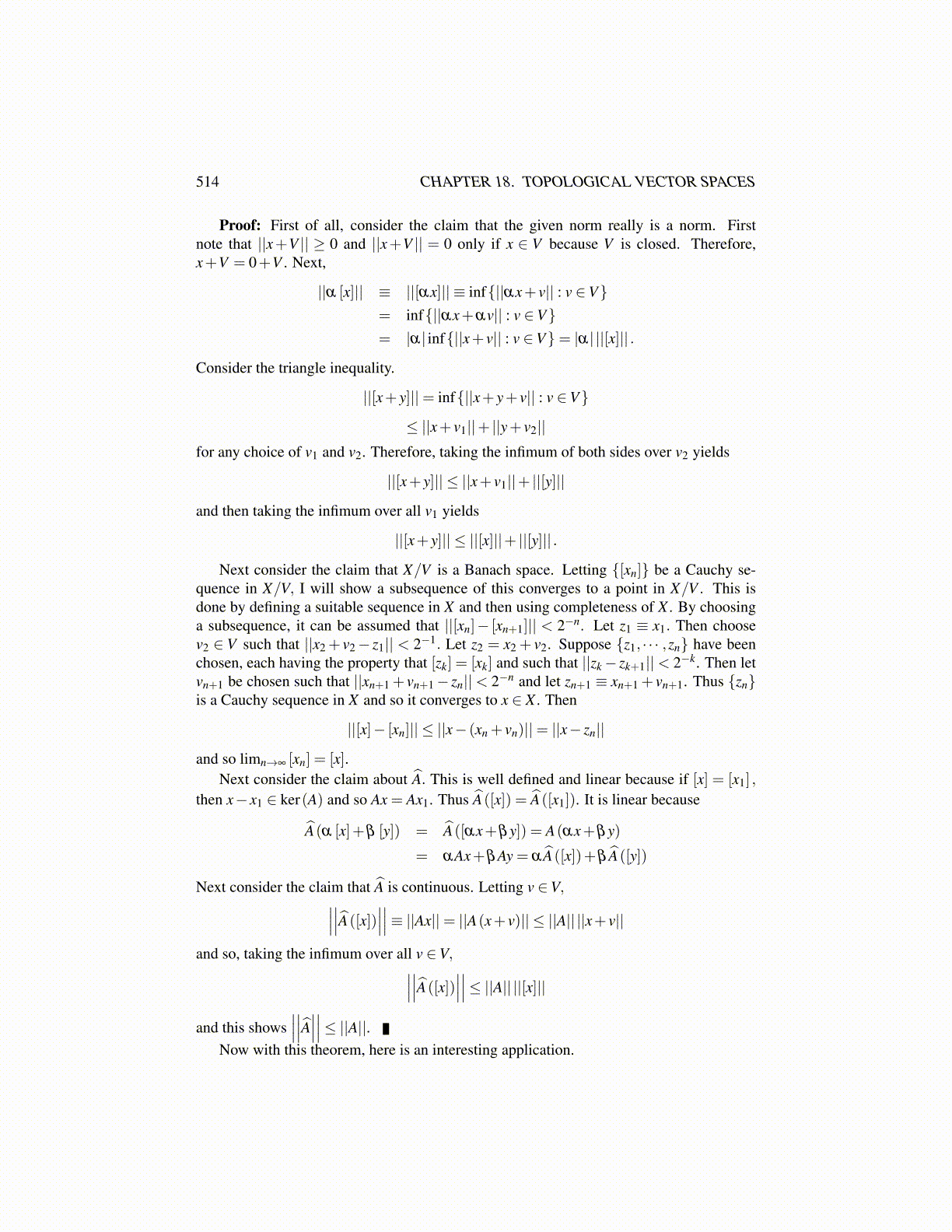
514 CHAPTER 18. TOPOLOGICAL VECTOR SPACES
Proof: First of all, consider the claim that the given norm really is a norm. Firstnote that ||x+V || ≥ 0 and ||x+V || = 0 only if x ∈ V because V is closed. Therefore,x+V = 0+V . Next,
||α [x]|| ≡ ||[αx]|| ≡ inf{||αx+ v|| : v ∈V}= inf{||αx+αv|| : v ∈V}= |α| inf{||x+ v|| : v ∈V}= |α| ||[x]|| .
Consider the triangle inequality.
||[x+ y]||= inf{||x+ y+ v|| : v ∈V}
≤ ||x+ v1||+ ||y+ v2||for any choice of v1 and v2. Therefore, taking the infimum of both sides over v2 yields
||[x+ y]|| ≤ ||x+ v1||+ ||[y]||
and then taking the infimum over all v1 yields
||[x+ y]|| ≤ ||[x]||+ ||[y]|| .
Next consider the claim that X/V is a Banach space. Letting {[xn]} be a Cauchy se-quence in X/V, I will show a subsequence of this converges to a point in X/V . This isdone by defining a suitable sequence in X and then using completeness of X . By choosinga subsequence, it can be assumed that ||[xn]− [xn+1]|| < 2−n. Let z1 ≡ x1. Then choosev2 ∈ V such that ||x2 + v2− z1|| < 2−1. Let z2 = x2 + v2. Suppose {z1, · · · ,zn} have beenchosen, each having the property that [zk] = [xk] and such that ||zk− zk+1||< 2−k. Then letvn+1 be chosen such that ||xn+1 + vn+1− zn||< 2−n and let zn+1 ≡ xn+1 + vn+1. Thus {zn}is a Cauchy sequence in X and so it converges to x ∈ X . Then
||[x]− [xn]|| ≤ ||x− (xn + vn)||= ||x− zn||
and so limn→∞ [xn] = [x].Next consider the claim about Â. This is well defined and linear because if [x] = [x1] ,
then x− x1 ∈ ker(A) and so Ax = Ax1. Thus Â([x]) = Â([x1]). It is linear because
Â(α [x]+β [y]) = Â([αx+βy]) = A(αx+βy)
= αAx+βAy = αÂ([x])+β Â([y])
Next consider the claim that  is continuous. Letting v ∈V,∣∣∣∣∣∣Â([x])∣∣∣∣∣∣≡ ||Ax||= ||A(x+ v)|| ≤ ||A|| ||x+ v||
and so, taking the infimum over all v ∈V,∣∣∣∣∣∣Â([x])∣∣∣∣∣∣≤ ||A|| ||[x]||
and this shows∣∣∣∣∣∣Â∣∣∣∣∣∣≤ ||A||.
Now with this theorem, here is an interesting application.